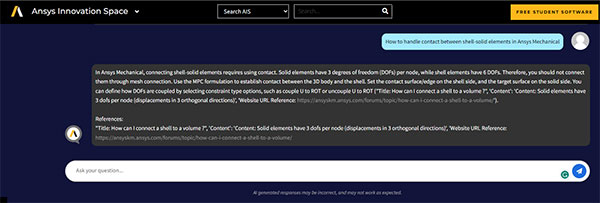
Ansys launches AnsysGPT, tech support powered by ChatGPT technology from Open AI. Image courtesy of Ansys.
Latest News
July 27, 2023
This week, Ansys announced it's launching a beta version of AnsysGPT, a virtual assistant trained on natural language processing. The name itself identifies the source of the technology and what you might expect from it.
Ansys announced, “Developed using state-of-the-art ChatGPT technology available via the Microsoft Azure OpenAI Service, AnsysGPT uses well-sourced Ansys public data to answer technical questions concerning Ansys products, relevant physics, and engineering topics within one comprehensive tool. Expected in early 2024, AnsysGPT will optimize technical support for customers—delivering information and solutions more efficiently, furthering the democratization of simulation.”
The launch of AnsysGPT is consistant with the vision revealed by Dr. Prith Banerjee, CTO of Ansys, at OzenCon in March. At the conference, Banerjee discussed using ChatGPT-style natural-language processing to train an AI chatbot to provide first-level tech support.
“Unlike general AI virtual assistants that use unsupported information, AnsysGPT is trained using Ansys data to generate tailored, applicable responses drawn from reliable Ansys resources including, but not limited to, Ansys Innovation Courses, technical documentation, blog articles, and how-to-videos. Strong controls were put in place to ensure that no proprietary information of any kind was used during the training process, and that customer inputs are not stored or used to train the system in any way,” explained Ansys.
AnsysGPT is designed to be an incremental option for additional customer support, clarified Anthony Dawson, VP of Customer Excellence at Ansys. “At all times during use, a prominent option is available that will allow users to return to standard Ansys support options,” he added.
Beta testing involves “dozens of users from our customer base and channel partner network,” according to Dawson. He expects the test program will expand over time.
“AnsysGPT was developed both to enhance our customer support experience and free up time on our technical support team so that they can focus on other challenging problems and provide more advanced support. As beta testing progresses, we’ll get a better idea of the extent to which the service can reduce customer support workloads,” he said.
Dawson calls the birth of AnsysGPT a significant milestone in the company's ongoing journey to integrate AI (Artificial Intelligence/Machine Learning). “AnsysGPT complements existing AI integration across Ansys’ portfolio, including computational fluid dynamics (CFD) solvers that leverage AI/ML to improve turbulence models, structural tools that apply AI/ML to predict computational spend, and process integration and design optimization software that employs AI/ML to efficiently build reduced order models,” he added.
At OzenCon, Banerjee has said, “Today, when you use a simulation tool such as Ansys HFSS for electromagnetic simulation or Ansys Fluent for fluid simulation, you -must set up a hundred different parameters. You have to almost have a Ph.D. in aerospace engineering to know which parameters to set. In the future, with technology like ChatGPT, you can actually say, ‘Run an external aerodynamic simulation over a Boeing 747 plane,’ and it will figure out for that particular case, what are the fluid settings to use.”
Along with Ansys, many other simulation software makers are exploring ways to incorporate AI-powered features with natural language processing. For more, read “Text-Messaging My Software for Ideas,” July 2023.
More Ansys Coverage
Subscribe to our FREE magazine, FREE email newsletters or both!
Latest News
About the Author
Kenneth Wong is Digital Engineering’s resident blogger and senior editor. Email him at [email protected] or share your thoughts on this article at digitaleng.news/facebook.
Follow DERelated Topics






